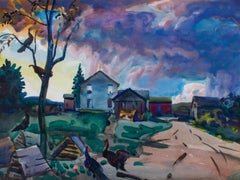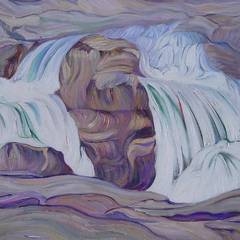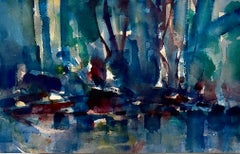American Modern Landscape Paintings
Style: American Modern
Color: Purple
Turkeys in the Trees, Early 20th Century Farm Landscape Watercolor
By Frank Wilcox
Located in Beachwood, OH
Turkey in the Trees, c. 1922
Watercolor on paper
Signed lower right
22 x 29 inches
Frank Nelson Wilcox (October 3, 1887 – April 17, 1964) was a modernist American artist and a mast...
Category
1920s American Modern Landscape Paintings
Materials
Watercolor
Lavanda- Vibrant Purple Red Southwest Inspired Pop Art Cactus Painting
By Will Beger
Located in Los Angeles, CA
Will Beger and his contemporary-minimalist paintings, take on an entirely unique approach to southwest art. Influenced by his youth and inspired by nature, he effortlessly captures a...
Category
21st Century and Contemporary American Modern Landscape Paintings
Materials
Resin, Mixed Media, Acrylic, Wood Panel
Waterfall (Woodstock, New York)
Located in Concord, MA
GRACE HILL TURNBULL (1880-1976)
Waterfall (Woodstock, New York), c. 1925
Oil on canvas
14 x 20 inches
Unsigned
PROVENANCE
The Maryland Historical Society
The work of pai...
Category
1920s American Modern Landscape Paintings
Materials
Canvas, Oil
Related Items
Modernist Abstract Expressionist Watercolor Painting Bauhaus Weimar Pawel Kontny
By Pawel Kontny
Located in Surfside, FL
Abstract watercolor composition bearing the influence of the earlier color-block compositions of Paul Klee.
Pawel August Kontny, (Polish-German-American artist) He was born in Laurahuette, Poland, in 1923, the son of a wealthy pastry shop owner. In 1939 he began studying architecture in Breslau where he was introduced to the European masters and to the work of some of the German Expressionists, soon afterward banned as "degenerate artists" and removed from museums throughout Germany by the Nazi regime. His studies were interrupted by World War II. Drafted into the German army, traveling in many countries as a soldier, he sketched various landscapes but in 1945, he was captured and held as a prisoner of war in Italy. After the war, he studied at the Union of Nuremberg Architects to help design buildings to replace ones destroyed in the war. He recorded his impressions of the local population and the landscapes through his watercolors and drawings. Pawel Kontny thereafter moved to Nuremberg, Germany, becoming a member of the Union of Nuremberg Architects and helping to rebuild the city's historic center. He soon decided to concentrate on his professional art career. He married Irmgard Laurer, a dancer with the Nuremberg Opera. Pavel Kontny 's career as an artist was launched with his participation in an all German exhibition, held at the Dusseldorf Museum in 1952. He held one-man shows in Germany, Switzerland and the United States. During his trip to the United States in 1960, Kontny became instantly enamored with Colorado, and decided to relocate to Cherry Hills with his wife and two children. He quickly established himself in the local art community, being affiliated for a time with Denver Art Galleries and Saks Galleries. His subject matter became the Southwest. During this time he received the Prestigious Gold Medal of the Art Academy of Rome. His extensive travel provided material for the paintings he did using his hallmark marble dust technique. he also worked equally in pastel, watercolor, charcoal and pencil-and-ink. in a style which merged abstraction and realist styles, influenced by Abstract Expressionist painting and South Western American landscapes. In the early 1960s he was one of only a few European-born professional artists in the state, a select group that included Herbert Bayer (1900-1985), a member of the prewar Bauhaus in Weimar and Dessau, Germany, and Roland Detre (1903-2001), a Hungarian modernist painter. As a Denver, Colorado resident, Pavel Kontny exhibited at galleries and museums throughout the United States, Germany and Japan. There, he was inspired by frequent trips to Native American pueblos in the Southwest, as well as by the study of the Plains Indians of Montana and Wyoming. Over the years Kontny had a number of students and generously helped young artist by hosting exhibitions at his Cherry Hills home. For many years he generously donated his paintings to support charitable causes in Denver. Influences during his European years included German pastelist C.O. Muller, German Informel painter Karl Dahmen and Swiss artist, Hans Erni. In the early 1950s his painting style showed the influence of the Die Brücke (The Bridge), a group of German expressionist artists formed in Dresden in 1905 who had a major impact on the evolution of modern art in the twentieth century in Germany. By the middle of the decade his style incorporated more referential abstraction and total abstraction, resulting in part from his study of Hans Hartung, a German artist based in Paris who exhibited his gestural abstract work in Germany. The American moon landing in 1969 inspired Paul Kontny...
Category
20th Century American Modern Landscape Paintings
Materials
Canvas, Oil
Central City, Colorado, 1950s Modernist Cityscape Oil Painting with Buildings
Located in Denver, CO
Oil on canvas modernist city scape painted circa 1950 by Paul K Smith (1893-1977) titled Central City, Colorado. Portrays a city scene of historic buildin...
Category
1950s American Modern Landscape Paintings
Materials
Canvas, Oil
Abstract Street (Untitled)
By Hananiah Harari
Located in Los Angeles, CA
This painting is part of our exhibition America Coast to Coast: Artists of the 1930s
Abstract Street (Untitled), 1939, oil on canvas, signed and dated lower right, 12 x 32 inches; provenance includes a private collection in Venice, California; presented in what is likely the artist's original handmade frame
About the Painting
The present work is the culmination of a series of mainly horizontal urban abstractions Harari completed between 1937 and 1939. Deeply influenced by Stuart Davis, Harari’s New York streetscapes began with clearly recognizable objects and landmarks as in Into New York (1937 - Collection of the Whitney Museum of American Art), New York Harbor (1937), Up and Downtown (1938), and his other mural proposals for the Nurses Home on Welfare Island (1937) and the Williamsburg Housing Project (1938). At the end of the series, Harari’s vistas became increasingly abstract with broad planes of color representing buildings and streets, the slightest cross-hatching forming a bridge or elevated train track and the vague suggestion of a streetlight looping in the right center of the composition. Figures, birds, and a street vendor’s cart are reduced to pictograms scratched into the surface of the canvas. Abstract Street (Untitled) is among Harari’s most spare works of the 1930s and 1940s and calls to mind the seemingly childlike, but deeply sophisticated works of Paul Klee from the 1920s. It serves as an excellent reminder of why Harari was heralded as one of the earliest members of the American Abstract Artists.
About the Artist
Hananiah Harari was an artistic polyglot who was equally at home working in styles as diverse as Cubism, Constructivism, Expressionism, Hard Edged Abstraction and trompe l’oeil Realism. A native of Rochester, New York, Harari initially studied as a child at the Memorial Art Gallery in his hometown and later as a scholarship student at the College of Fine Arts at Syracuse University. In 1932, Harari left for Paris where he befriended Nahum Tschacbasov, Benjamin Benno and John Graham and studied at the ateliers of Lhote, Leger and Gromaire. He also studied fresco painting at the Ecole de Fresque. By 1933, Harari had completed enough work and gained a sufficient reputation to have a solo exhibition at the American Club in Paris. The following year, Harari and his childhood friend and fellow artist Herzl Emanuel traveled to Palestine, where the artists worked hard in the orchards and fields of Kibbutz Deganiah, but produced little art. After returning to New York, Harari married Emanuel’s sister, Freda, and set out on the development of what noted scholar Gail Stavitsky has called an “original synthesis of the old and new." Harari became an early member of the American Abstract Artists (AAA), an organization formed to give modernists exhibition opportunities. Harari was also a member of the socially conscious Artist’s Union and the American Artist’s Congress. From 1936 through 1942, Harari worked on the Federal Art Project and assisted Marion Greenwood on a project as part of the Mural Division, but to his disappointment did not lead his own project. During the late 1930s and early 1940s, Harari completed a series of paired paintings with the same subject matter depicted in a Cubist manner and in trompe l’oeil Realism. Harari was acclaimed by Clement Greenberg and six of the artist’s works were selected for the Museum of Modern Art’s important 1943 exhibition American Realists and Magic Realists. During World War II, Harari served in the US Army Air Corps. Following the war, Harari continued to produce fine art while also producing commercial art. During the McCarthy Era, Harari’s progressive politics and leftist leaning art...
Category
1930s American Modern Landscape Paintings
Materials
Oil
Shanty Town
Located in Buffalo, NY
You are viewing a modernist American acrylic painting depicting a charming but rundown seaside town at night.
Robert Noel Blair (American, 1912-2003) was an American artist, paint...
Category
1950s American Modern Landscape Paintings
Materials
Acrylic, Archival Paper
Large 1960 California "Abstract Landscape" Jack Stuck Painting
Located in Arp, TX
Jack Stuck (1925-1993)
"Abstract Landscape"
1960
Collage oil paint, charcoal, paper and canvas laid down on masonite
48"x46" natural wood frame 51" x 49"
Si...
Category
Mid-20th Century American Modern Landscape Paintings
Materials
Canvas, Masonite, Charcoal, Oil, Laid Paper
H 49 in W 51 in D 2 in
Mid Century Modern Abstracted Cityscape Oil Painting, American Modern, Red Black
Located in Denver, CO
Mid 20th century oil and spackle painting featuring an abstracted cityscape with a bridge and buildings by Henriette "Yetti" Stolz. Signed by the artist in the lower right margin. Pa...
Category
Mid-20th Century American Modern Landscape Paintings
Materials
Oil, Board, Putty
H 25.75 in W 61.75 in D 1 in
Central City, Colorado, 1950s Semi-Abstract Cityscape Gouache Painting, Red Blue
Located in Denver, CO
'Central City, Colorado' by Leonard Silverstein is an original gouache on paper from 1954. Hand signed, titled, and dated by the artist in the lower right...
Category
1950s American Modern Landscape Paintings
Materials
Gouache, Archival Paper
H 20.5 in W 26.5 in D 1.5 in
Vintage Southern California Abstract Landscape Painting - Katharyn Truesdell 70s
Located in Baltimore, MD
Katharyn Gwendoln Truesdell - (American; 1909-1996)
This colorful painting depicts a Southern California valley, likely near Sun City, over the mountains from Los Angeles and San Di...
Category
1970s American Modern Landscape Paintings
Materials
Oil
Blue Super Moon Over Havana, imaginative large scale abstract cityscape
By C. Dimitri
Located in Brooklyn, NY
Oil paint and mixed media on repurposed bulletin board.
Note, the wood border is part of the artwork, not to be mistaken for an actual "frame."
Category
2010s American Modern Landscape Paintings
Materials
Mixed Media, Oil, Acrylic, Wood Panel
H 48 in W 72 in D 2 in
Triptych Abstract Forest Trees Landscape Painting by British Urban Artist
Located in Preston, GB
Early Triptych Abstract Trees Forest Landscape Painting by British Urban Artist, Angela Wakefield. This rare early work is from an intense body of abstract work that formed the very ...
Category
1990s American Modern Landscape Paintings
Materials
Gesso, Paint, Varnish, Mixed Media, Oil, Acrylic, Wood, Board, Wood Panel
"Hydrangeas, " Walter Inglis Anderson, Mississippi Southern Illustrator, Flowers
Located in New York, NY
Walter Anderson ( American, 1903 - 1965)
Hydrangeas, circa 1950
Mixed media on paper
11 x 8 1/2 inches
Provenance:
Luise Ross Gallery, New York
Private Collection, New Jersey
Acquired from the estate of the above, 2021
Walter Anderson firmly believed that quality art was an important part of life and should be made available to everyone. As he said, "There should be simple, good decorations, to be sold at prices to rival the five-and-ten." Noticing that only poor quality art was available in stores and little was available for children, he resolved to make art which could be reproduced easily and sell inexpensively — linoleum block prints. This technique enabled him to provide affordable, quality art.
The technique of linoleum block printing is a simple concept; however, it requires much skill and talent to actually produce memorable art. Anderson purchased surplus "battleship linoleum," thicker than ordinary linoleum with a burlap backing for better support, to create his blocks. During the mid-1940s, he created almost 300 linocuts working in the attic of the sea-side plantation house, Oldfields, his wife's family home in Gautier. Masses of linoleum chips accumulated at the foot of the attic stairs as he often worked night and day. He began with sketching out a design directly on the linoleum. Once he had carved the image into the surface, he used the back of faded, surplus stock wallpaper that a friend sent him, laying long strips on top of the inked linoleum. A roller made of sewer pipe filled with sand served as his press. When the print was completed, he often colored it by hand with bold strokes and vivid colors. The prints were sold at Shearwater Pottery, the family business, for a mere dollar a foot.
But "what about a well-designed fairy tale for a child's room?" he asked himself. Since there was a lack of affordable art for children, much of his work with linoleum blocks focused on subjects for children. He depicted fables and fairy tales ranging from Arabian Nights, to Germany and the Grimm Brothers' Rapunzel, to the French story of The White Cat, to the Greek tales such as Europa and the Bull, and to tales from China, India, and other cultures. Anderson also created "mini" books featuring the alphabet and Robinson Cat. The blocks are not only alive with the story being depicted, but they are also filled with designs taken from Best-Maugard's Method for Creative Design. Swirls, half-circles and zig-zag lines fill every available space on the linoleum block making them come alive and capture their audience.
But fairy tales, children's verses and the "mini" books, consisting of about 90 blocks, were not the sole subject of Anderson's linoleum block prints. In total, he created approximately 300 linoleum blocks with subjects ranging from coastal flora and fauna, coastal animals, and sports and other coastal activities. Anderson even created linoleum blocks to be used to print tablecloths and clothing, some worn by his own children. Color and subjects of the linoleum block prints were not the only things that got them noticed.
In 1945 when Anderson was creating these prints, the standard size of linoleum block prints was only 12 by 18 inches. These small dimensions were due to the common size of the paper available and the restrictions made by national competitions. Since Anderson used wallpaper...
Category
Mid-20th Century American Modern Landscape Paintings
Materials
Paper, Crayon
The Surf at Newport
Located in Storrs, CT
The Surf at Newport (Rhode Island). c. 1906. Oil on canvas. 17 x 24 (framed 26 x 34). Lined; extensive craquelure; otherwise fine condition. Housed in an exceptional Louis XV (reviva...
Category
Early 20th Century American Modern Landscape Paintings
Materials
Oil
American Modern landscape paintings for sale on 1stDibs.
Find a wide variety of authentic American Modern landscape paintings available for sale on 1stDibs. Works in this style were very popular during the 21st Century and Contemporary, but contemporary artists have continued to produce works inspired by this movement. If you’re looking to add landscape paintings created in this style to introduce contrast in an otherwise neutral space in your home, the works available on 1stDibs include elements of blue, orange, purple, pink and other colors. Many Pop art paintings were created by popular artists on 1stDibs, including Francis Chapin, Harold Haydon, Frank Wilcox, and Donald Stacy. Frequently made by artists working with Paint, and Oil Paint and other materials, all of these pieces for sale are unique and have attracted attention over the years. Not every interior allows for large American Modern landscape paintings, so small editions measuring 5 inches across are also available. Prices for landscape paintings made by famous or emerging artists can differ depending on medium, time period and other attributes. On 1stDibs, the price for these items starts at $300 and tops out at $800,000, while the average work sells for $5,500.
Recently Viewed
View AllMore Ways To Browse
Sunset Oil Hudson
Emile Breton
Edward Warmly
Luxembourg Gardens
Richard Smith Contemporary Artist
Richards Oil
Impressionist Painting Bedroom
D H Lawrence
Corot Jean
Rain In The Mountains
Antique Gloucester
Forever 21
Paintings Honfleur
Oil Painting Large Scenery
Antique Hudson River
Fire Coast
Windmill Oil
Beach Scene 19th



